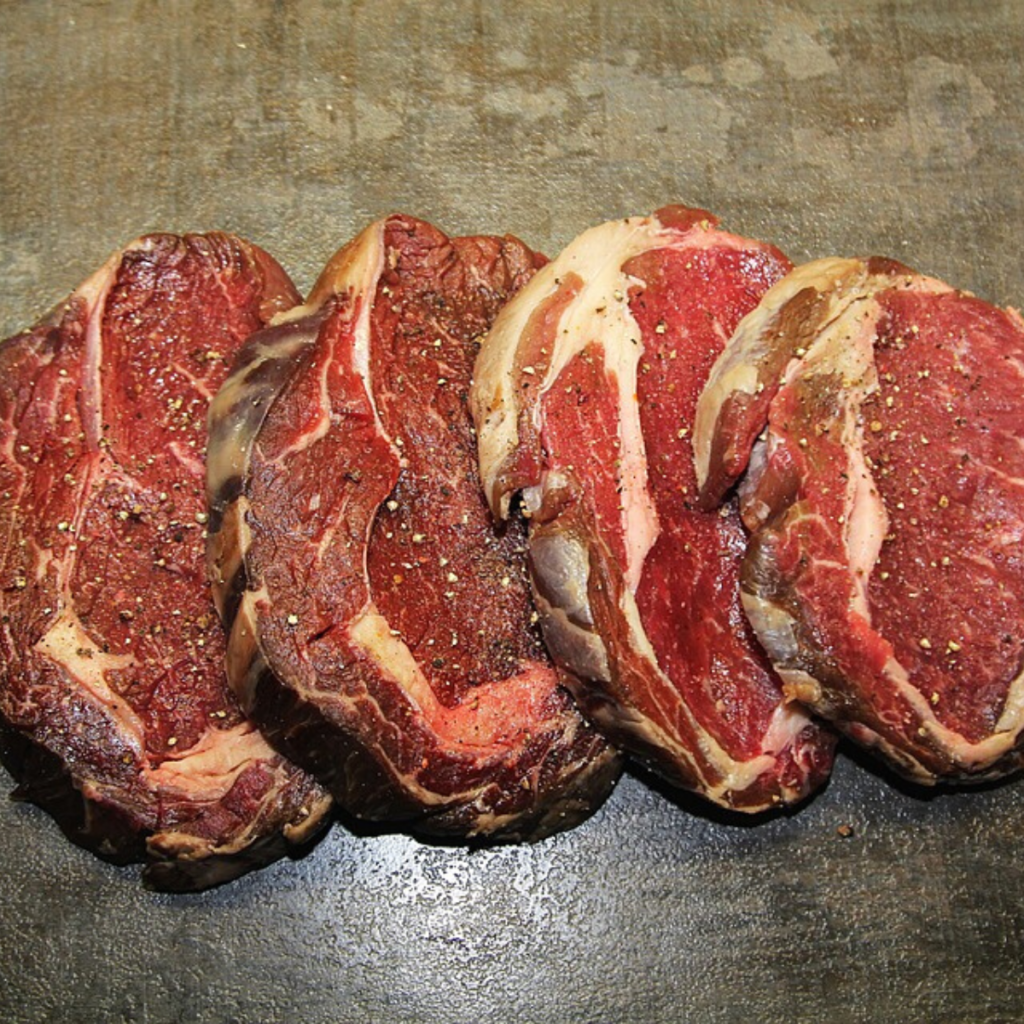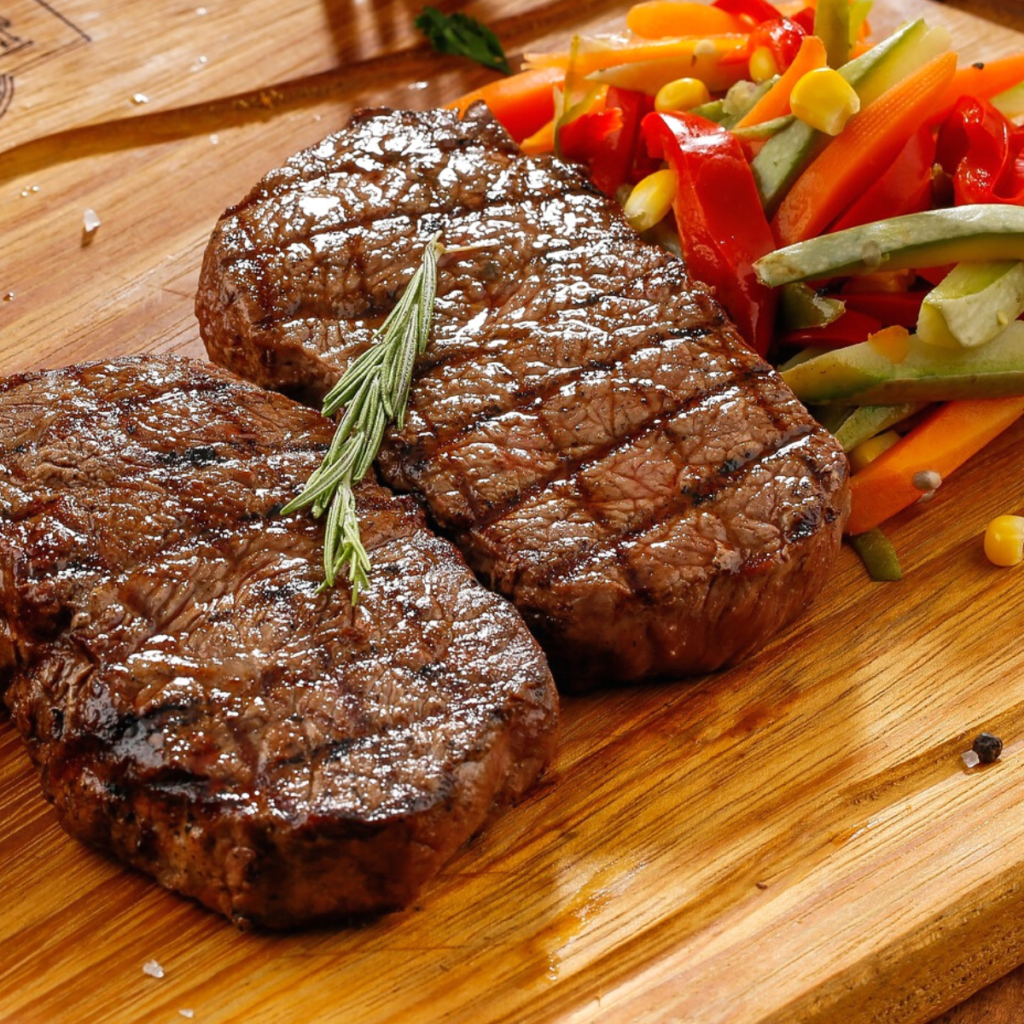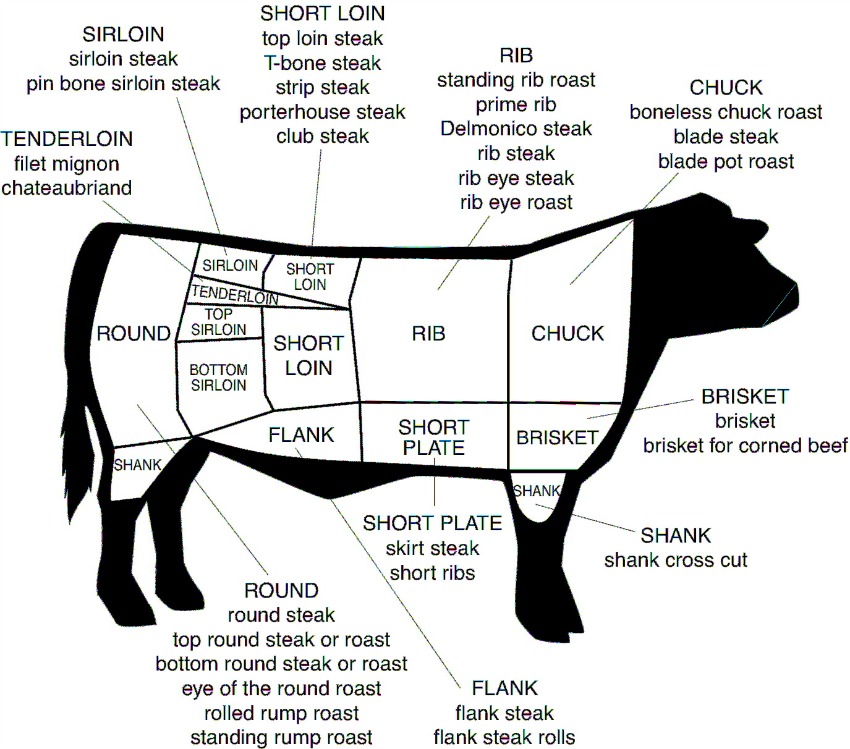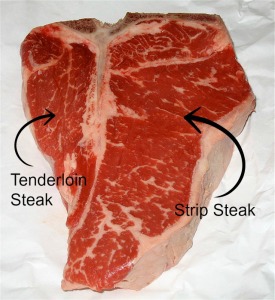
Steak. There’s no other piece of meat quite like it. At our house, having a steak is an event. It doesn’t matter if we’re celebrating something big or small, a steak night is something we look forward to.
However, we also know that steak can be intimidating. For example, have you ever been at a steakhouse and seen an endless list of steaks to choose from? What’s the difference between the steaks? Do they really taste that different? Not to mention, how do you want it cook (most choose medium-rare).
To help you feel at ease cooking a steak at home or ordering a steak at a restaurant, we’ve listed the top 4 steaks and their characteristics. Keep in mind that the answer to “what’s the best cut of steak?” will vary a little by personal preference and taste, but this guide will get you started.
But before we figure out your favorite steak cut, let’s do a quick history lesson.
Best Cut of Steak….Yesterday and Today
The word “steak” has a long culinary history. A steak (from Old Norse “steik” or “steikja”) is a cut of meat. Today we usually think of steaks as being beef, but it wasn’t always that way. The Oxford English Dictionary’s first reference of steak is to a “thick slice of meat cut for roasting or grilling or frying, sometimes used in a pie or pudding.” The dictionary entry goes on to talk about “steak fish”, and old 15-century books also talk about steaks when referring to venison or beef.
And throughout history, the best cut has varied some – but not much. Here’s an entry from Mary Randolph who wrote one of America’s first cookbooks, “The Virginia Housewife” published in 1827. This was a prized cookbook before the Civil War and Ms. Randolph talks about her favorite cut and how to cook it.
The best part of the beef for steaks, is the seventh and eighth ribs, the fat and lean are better mixed, and it is more tender than the rump if it be kept long enough; cut the steaks half an inch thick, beat them a little, have fine clear coals … broil them quick, turning them frequently; the dish must be very hot, some slices of onion on it, lay in the steaks, sprinkle a little salt … Everything must be in readiness, for the great excellence of a beef steak lie in having it immediately from the gridiron. — Mary Randolph, “The Virginia Housewife,” 1827.
Based on this description, Mary liked steak from the Rib or Loin area that was hot off the grill. These would have been cuts like Filet, Strip Steak, Ribeye and T-Bone.

Where to find the best cut of steak
The best cut of steak come from the top and center of the steer. The general rule of thumb for any cut of meat is to remember that beef gets more tender as the distance from the horn and hoof increases. A steer’s legs do most of the work, so the muscles there are firmer. The loin and ribs don’t get as much of a workout, so they’re more tender. If you need a refresher about all beef cuts, check out What Everybody Ought to Know About Beef Cuts.
What’s the best cut of steak for me?
There are four cuts that are the most popular with steak aficionados and steakhouses — tenderloin, ribeye, strip and T-bone. Most likely, one of these four will be your personal favorite and is how you’ll soon answer the question, “what’s the best cut of steak?”

1. Ribeye – Very marbled. The most juicy and flavorful cut of steak
- Also Known As: Delmonico Steak, Scotch Filet, Cowboy rib eye steak (when served with rib still attached, i.e. bone-in)
- Taste and Texture: The ribeye is the king of steaks. It’s the most juicy and flavorful of all steaks. It gets its amazing flavor from the fat marbling, which you will see throughout the cut. If you’re not a fan of beef marbling, this isn’t the cut for you. The ribeye steak is incredibly tender and juicy, and it offers a melt-in-your-mouth sensation.
- Where it comes from: Ribeye steak comes from the “eye,” or center, of a cow’s rib portion
- Cooking Recommendations: Ribeye steaks are very versatile pieces of meat. We like to keep preparation simple with this cut so the beefy flavor shines through — simply season with salt and pepper and cook over high heat. We recommend pan-seared using a cast iron skillet, grilled or broiled. If you decide to grill it, be careful about flareups from the fat. If desired, you can cook a ribeye a little past medium because of its high-fat content.
- Note about bone-in ribeye, Cowboy steak: Ribeye steak also has a bone-in variety that is known as a cowboy rib eye steak. This steak cut contains more meat that extends beyond the eye. The cowboy steak also has generous marbling that offers great tenderness.
2. Tenderloin – The most tender cut of steak
- Also Known As: Filet, Filet mignon, Chateaubriand.
- Taste and Texture: Tenderloin is by far the tenderest cut of beef. It’s buttery and mild in flavor. Of all of the high-end steaks, this is the one with the least amount of fat, and it will melt in your mouth since it’s so tender.
- Where it comes from: The tenderloin is a cut from the short-loin. Cows don’t exert this muscle very much, so it has little connective tissue and therefore makes it an extremely tender and flavorful cut of meat. Some consider it the best meat on a steer.
- Cooking Recommendations: The tenderloin is a very buttery and mild steak. Said another way, it doesn’t have as much flavor as other steaks. It also has a very low-fat content, which means it will quickly dry out if you cook it for too long. You’ll want to be extra attentive when cooking this steak cut. At our house, we like to grill tenderloins, but you could also pan sear them in a buttery sauce. To add more flavor, you’ll often see this on restaurant menus wrapped in bacon before grilling or served with sauces or spices.
3. Strip Steak – An all-around favorite with full-beefy flavor
- Also Known As: New York Strip, Kansas City Strip, Top Sirloin, Top Loin, Club Steak, Shell Steak.
- Taste and Texture: Strip steaks have a great beefy flavor. The texture has a fine, tight grain that makes them moderately tender. It has less marbling than a ribeye, which means it’s a little chewier (tough) than the ribeye or tenderloin. This is a staple and classic at any steakhouse.
- Where it comes from: Short Loin
- Cooking Recommendations: This steak is easy to cook, which makes it a personal favorite with many people. We recommend grilling, but you can also cook in a pan with oil and spices, or roast in the oven with potatoes. The sky is the limit cooking the strip steak because it’s very versatile.
4. T-Bone – Two-for-one steak
- Taste and Texture: If you’re undecided on what type of steak texture and taste you like, or you like both equally, the T-bone is for you. The T-bone is actually a combination of two steaks – tenderloin and strip. That means with this amazing two-fer steak, you get a tender and buttery tenderloin filet on one side of the T-shaped bone, and a beefy strip steak on the other side.
- Where it comes from: Short loin
- Cooking Recommendations: Grilling or broiling. While cooking, you’ll want to keep in mind that the meat near the bone tends to cook more slowly than the other parts of the steak. Also, if you’re grilling, put the tenderloin portion further away from the heat source than the strip. This is because the T-bone has two different pieces of meat that cook differently (tenderloin cooks faster than the strip steak).
- Note about porterhouse steak: A porterhouse steak is just a T-bone with a larger tenderloin. It comes from the hindquarter of the cow, and contains the exact same cuts as the T-bone steak, with slightly more of the tenderloin than in a T-bone. If it did not contain more tenderloin than a T-bone steak, then it would not be considered a porterhouse.
That’s it. The Ribeye, Filet, Strip and T-Bone are the top four best cuts of steak. Hopefully, that has helped simplify it for you the next time you’re deciding what type of steak to cook or order at a restaurant.
Other Popular Steak Cuts:
Above are the four most popular cuts, but there are more than these four steak cuts on a steer. There are also cuts like top sirloin steak, bottom sirloin steak, hanger steak, and skirt steak. Here’s a quick overview of those cuts, too.
Sirloin
The sirloin is one of the most well-known cuts of beef. Sirloin is the large primal section of beef in the hip section of the animal, just ahead of the rump. This primal cut is generally divided up into the top sirloin and bottom sirloin. The top sirloin is more flavorful and tender than the tougher bottom sirloin.
You’ll generally find a sirloin steak on a steakhouse menu, and it will be at a lower price point.
Cooking the top sirloin steak is easy and it can be used for a variety of recipes and dishes. A Sirloin Steak is a lean, inexpensive cut that makes it an all-around favorite. In addition to being a great steak, it’s also ideal for kabobs.
Flank Steak
Flank Steak is very distinct because of grains that run the length of the cut. It comes from the lower side of the plate primal cut on a cow. A flank steak is a tougher cut, but full of flavor because it’s full of connective tissue. It’s a lean and flavorful cut that can sometimes be slightly chewy. It’s a thin cut that will cook quickly, so it’s ideal for a weeknight meal. This steak is best cut very thin.
Skirt Steak
Skirt steaks is a long, thin piece of meat that has visible muscle fibers running along the steak’s width. It’s somewhat similar to the flank steak, and the two cuts are often confused, but they are different. The main difference between the two is where they come from. The Skirt steak is a thin, flavorful cut located in the diaphragm area of the cow, while the flank is located directly under the cow’s loin. Skirt steak do extremely well with marinade, slow-cooking, and stir-frying. Skirt steak should be cooked on either side for about three minutes
Kitchen Products We Love
One More Thing!
Do you want to learn more about beef? Join our weekly e-newsletter where we share farm happenings, recipes and beef availability. Sign-up and get a cheat sheet with 9-must-ask questions before buying beef directly from a farmer. Or, we have an entire ebook about beef that goes through purchasing and preparing beef from a cattle farmer’s perspective.
Here are a few other links you may like:
- What everybody ought to know about beef cuts
- Buying a Cow. How Much Beef Is It?
- 7 Steps to Grilling a Steak to Perfection
- How We Raise Our Grass Fed Beef
- Bonfire Burger
- Prime Rib Roast with Garlic Herb Butter
Disclosure: This post contains affiliate links. This means if you click on the link and purchase the item, we will receive an affiliate commission at no extra cost to you. All opinions are our own and we only recommend products that we truly believe in.
We participate in the Amazon Services LLC Associates Program, an affiliate advertising program designed to provide a means for us to earn fees by linking to Amazon.com and affiliated sites. See our disclosure policy for more details.


